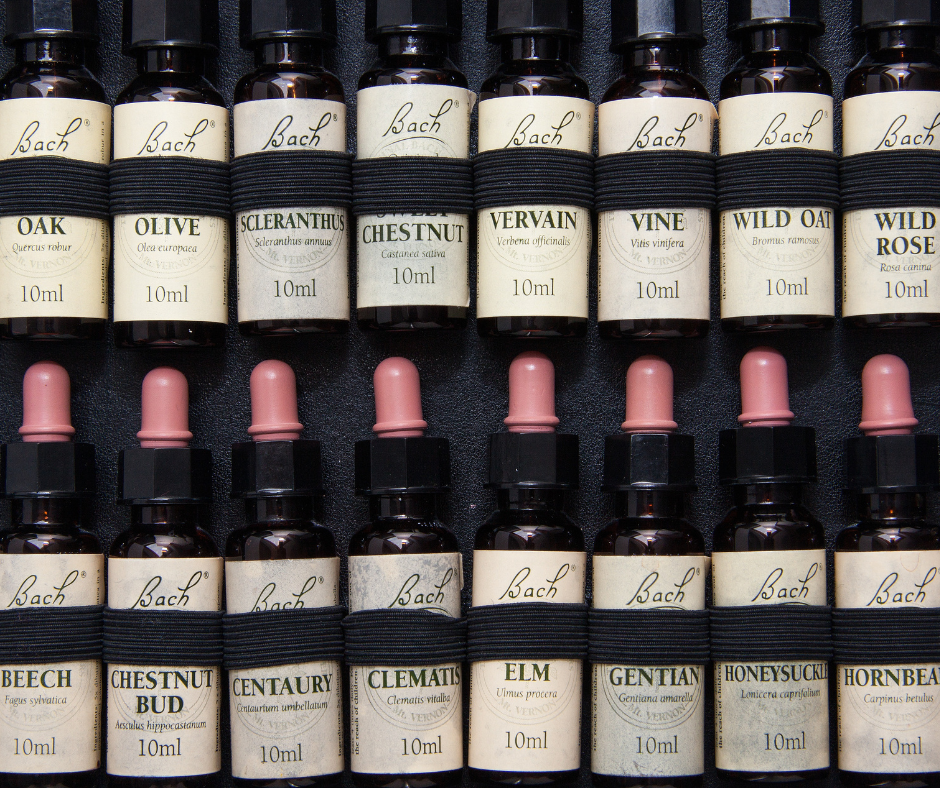Have you heard about them but can't quite imagine how they work? What are Bach flower essences, and how can they help you?
Bach flower essences, also known as Bach drops or simply Bach remedies, are a natural way to solve physical and emotional difficulties using extracts from wild-growing flowers and trees.
This method was discovered by the world-renowned doctor and English homeopath Dr. Edward Bach in 1928. During his practice, he noticed that traditional medicine focused mainly on treating symptoms rather than addressing the root cause of the problem. Dr. Bach was one of the first to shift his focus toward finding the true cause of health issues. Through his research, he invented:
"Health depends on whether our body is in harmony with our soul."
He dedicated himself to developing a way to help people restore lost harmony and balance. When the body is out of balance, symptoms of illness begin to appear.
How can we interpret this philosophical and, for its time, rather forward-thinking perspective today?
Dr. Bach believed that treating a patient required more than just focusing on the body and solving the consequences and symptoms of illness. He recognized that a person is more than just a physical being.
Dr. Edward Bach’s healing approach was based on his conviction that emotions, mental state, and physical health are deeply connected. He believed that most illnesses and physical problems start from emotional and psychological imbalances.

Bach believed in the healing power of nature and the idea that plants could transfer their energy to people. He selected specific flowers from plants and trees based on their ability to influence certain emotional states and mental characteristics.
Dr. Bach was a highly sensitive person. He felt things beyond what the human eye could see. His deep empathy allowed him to connect with individuals, and his bond with nature helped him understand which plant could cure them. Easily, Dr. Bach was like a modern-day herbalist. While grandmothers would give us herbal teas, Dr. Bach created essences from them.
To make this method of healing accessible to everyone, he developed a system that is now possible to study at the Dr. Bach Centre in London. Those who obtain Level 1 and Level 2 certifications can mix and prescribe Bach flower remedies to others.
Bach selected 38 different flowers, each representing a specific emotional state or mental characteristic.
In addition, he created one special essence called Rescue Remedy, which combines several flower essences and is made for urgent situations or moments of crisis.
The selection of flowers was based on the idea that each flower has a specific energetic resonance or vibration that can influence our emotional and mental health.
Bach believed that this energy could help restore balance and bring harmony to an individual’s emotional well-being.


After preparation, the essences are mixed with a preservative (alcohol or glycerol for babies and pregnant women) and are available in drop form. The user applies the drops directly on the tongue or put them in a glass of water, which has to be consumed immediately. Taking these essences can help overcome negative emotional thoughts and strengthen positive mental characteristics.
You can choose from pre-prepared blends of flower essences for specific problems ( Sleep or Weight Loss). If you have more problems to solve, we recommend you to choose Customized Bach essences - made especially for you. After filling out a simple questionnaire, Michaela E.G. Mašková will prepare a customized formula tailored to your needs, just as Dr. Bach originally did.
How can the body become unbalanced or ill?
No one taught us how to work with our emotions effectively. From an early age, parents told us:
"Big girls don’t whine, big boys don’t cry."
We may have heard things like:
"Calm down immediately, stop yelling!"
or
"Sit down and be quiet."
Everyone wanted us to be good girls and boys - quiet, well-behaved, and calm. A child wants to be accepted and loved, so they adapt to the expectations of their parents and surroundings, behaving in a way that ensures they are liked. In doing so, they also learn to suppress their emotions, even though those emotions need to be released.

Word emotion is made from word motion - meaning movement. An emotion needs to move, flow through the body, be fully experienced, and then leave.
Unfortunately, when we were children, no one liked it when we screamed, got angry, or stomped our feet. But that was our natural way of experiencing emotions. Since such behavior wasn’t acceptable, we were forced to keep all intense emotions inside us. No one taught us how to release emotions in a healthy and safe way. We didn’t know how to handle them, and the truth is that most adults didn’t either. Our pain, resentment, betrayal, misunderstanding, or sadness were stuck in the body.
That is the reason why we learned not to express emotions but to suppress them. Unfortunately, our parents had no one to teach them this either - they carry their own unresolved emotions through life. And in school, we were never taught how to release emotions in a healthy way. After years of accumulation, these unprocessed emotions begin to push their way to the surface.
How do emotions try to get out?
When we say "NO" to an emotion, we create an "illness."
Just like a child calling out for attention from their mother, emotions in our body act similarly - they need our attention.
That is the reason why women, for example, can feel under pressure. One wrong word, a single comment from their husband and they can turn into a big argument.
When we don't express and release our emotions healthily, it can eventually lead to illness. Saying "NO" to an emotion creates an "ILLNESS."
- Unresolved emotions often manifest as physical symptoms, such as pain in stomach, food allergies, or digestive issues.
- Fear can tighten the stomach and chest, restricting blood flow and oxygen to the body, which can lead to increased fatigue and anxiety.
- Body full of anger can be released through actions like teeth grinding, nail biting, eczema, or itching.

Anxiety, panic attacks, allergies, asthma, ADHD, poor concentration, insomnia, weight gain, painful periods, low libido, night terrors – all of these, and many more, can be caused by emotions that haven’t been properly released from the body.
How can emotion be stuck in our body?
It doesn't take much for an emotion to get stuck in the body. We might experience a traumatic event that brings us extremely strong emotions – fear, uncertainty, guilt, sadness, etc. You might think that you haven’t experienced something as extreme as the death of a parent, daily beatings, or hunger and poverty when you were younger.
But! We don’t judge the severity of a trauma based on its objective seriousness, but rather by the intensity of the emotional experience we felt in our body at that moment.

For example, a father tells his teenage daughter that her butt looks big in her skirt. She is hurt by this and feels the pain deep in her heart. From the most important man in her life, she hears an insult and feels a betrayal.
She walks away proudly, not letting it show (muttering to herself about her father), but she carries with her a feeling of being unloved, unaccepted, and moreover, unattractive. The seed of a low self-love is planted.
As an adult, she struggles in relationships, men don’t appreciate her, and she suffers, criticizing her body, which may manifest as weight gain and painful menstruation.
Or a person might have a bad school experience. A teacher humiliates a student in front of the whole class. The teacher laughs at him for not being able to read or tests him in front of the class, making fun of him for not knowing anything again. The unhappy boy experiences betrayal, ridicule, and humiliation, feeling embarrassed, worthless, and not good enough.
In the future, he may likely face situations where he feels the same way as that little boy in front of the class. His boss humiliates him in front of colleagues, his wife doesn’t appreciate him, and he earns little money because he feels he is not worth more.
What other consequences of stuck emotions can we experience?
- Relationship issues with partners and family,
- addictions, weight problems,
- high demands on himself/herself,
- workaholism, burnout,
- suicidal tendencies, self-harm,
- extreme worry about others,
- difficult adaptation to change,
- jealousy, hate towards others and himself/herself,
- fertility issues,
- mistrust, pessimism,
- procrastination, poor concentration, nostalgia,impatience, explosiveness, and even narcissism.


How can we release stuck emotions from the body today, even after several years?
Bach essences can help you! The Bach flower essences have spread not only throughout Europe but also to the USA.
The British royal family uses Bach flower essences, and they are provided free of charge to firefighters and police officers.
In France, Bach essences are registered as a medicine and can only be mixed by a pharmacist.
For midwives and teachers in the UK, they are an important part of their profession.
n Germany, Austria, and Switzerland, Bach essences are reimbursed by public health insurance with selected insurers, and only properly trained pharmacists in specialized pharmacies are allowed to mix them.
How do Bach essences work?
Dr. Bach worked with 7 emotional groups – fear, uncertainty, lack of interest, loneliness, oversensitivity, despair, and excessive care. These groups help to categorize emotions and mix the remedies tailored to individual needs. The essences work with negative thoughts that we try to completely remove.
An example could be stress, which triggers problems like hair loss, poor sleep, or acne. Common medications only act as suppressants, but Bach essences solve the situation at the root of the problem/block.
- Bach essences go deep and eliminate the source of your current troubles = long-term blocks and negations.
- By bringing out the negative first, you can once again experience calm, joy, gratitude, and well-being in life. Thanks to Bach essences, your body and mind are back in balance.
- Bach essences can remove up to 7 blocks at once.
- Bach essences don’t suppress symptoms; instead of that they solve the original cause.
